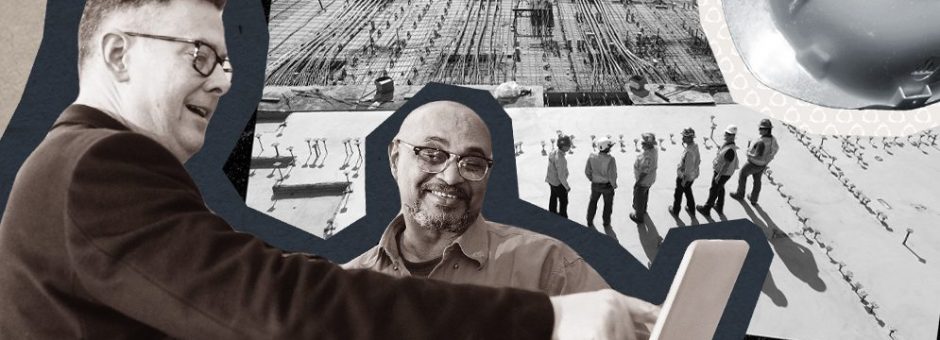As in many skilled trades and labour industries, the construction industry has steadily seen high employee turnover rates of around 25% for the past decade.1 2 During times of rapid infrastructural expansion across North America—read: when there is too much work for contractors to handle—workers may feel it is a labourers market, wherein job prospects seem unlimited, especially when competitors may be offering higher wages or more desirable projects. How, then, are construction companies meant to retain workers and stem high turnover rates? This endeavour begins at the top: by hiring a specialized human resources team.
It’s worth noting that the opposite can also be true. As Covid-19 restrictions have temporarily halted many construction projects, job turnover presently is comparatively low: because of so much uncertainty, if one has a job, they fight to keep it.3 Regardless, hiring a specialized human resources team is still beneficial as thoughtful employee management is perhaps now more important than ever.
For small to medium sized companies, human resources can seem like an unnecessary department that represents only the payment of numerous additional salaries every year. But it’s proven that excellent human resources with proper training will save you money—even when times are tough—by reducing employee turnover, retaining oversight on company culture, and safely managing employee disputes.4
Company-wide Oversight
It’s the task of human resources to develop policies and protocols for the complicated situations which can arise in the workplace. Companies without a robust or well trained human resources team are left to develop these plans alone, often without the legal knowledge required to reduce risk for the company.
As HR develops these policies, they do so with consistency and succession in mind. Company-wide oversight allows for comprehensive development of such policies as well as, importantly, their application. With such oversight comes the provision for impartiality during dispute resolution. All of these measures can—and frequently do—save companies money by resolving potentially costly lawsuits or settlements.
Oversight also includes the management of company culture, a workplace factor which has become increasingly important in recent years. Mitigating the possibility of a toxic work environment will also save money by reducing employee turnover.5
Robust Training Plans and Employee Opportunities
It’s also the domain of human resources to develop employee succession plans. Such plans, offering training opportunities, mentorship and other modes of career advancement, make employees feel they have a future with a company, thus motivating them to stay. In turn, the cost of onboarding external hires for specialized roles is reduced by grooming internal employees to rise up through the ranks.
HR will also manage the wages and wage structure of construction employees. It’s standard for the industry to offer competitive wages but empowering a robust human resources team to negotiate wages and other benefits at a one-on-one level with specific employees frees up management and executives to focus on the important day-to-day aspects of running the business.
Intersectional Human Resources
New Human Resource hires should be trained to respond to the needs of the workforce today: in a respectful, intersectional manner. “Intersectional”, referring literally to the point at which two lines meet at an angle, is a “theoretical framework for understanding how aspects of a person’s social and political identities might combine to create unique modes of discrimination and privilege.”6
Training in the application of this intersectional theory is especially important to the construction industry where many workers belong to racialized groups, are immigrants, or may be in a given country without valid documentation for working there. These are difficult circumstances and the management of such a workforce requires tact, thoughtfulness and dedication. Supporting employees of varying backgrounds goes beyond the basics and takes into account how their backgrounds and experiences might impact or enhance their work ethic. HR might build a specific plan for such employees, perhaps by negotiating a greater number of personal days or a more robust extended health care plan for employees with dependents. Such an approach is inherently competitive as it holds the potential to build employment terms suited to each employee, making them far less likely to leave.
Greater Value Over Time
Ultimately, cultivating a well trained and specialized human resources team through strategic hiring will not only save a company money over time, but will work to maintain a consistent and positive workplace environment. This team will develop and apply company wide policies, protecting employers from lawsuits and other disputes while ensuring the health and safety of employees. From the stressful times of COVID-19 to the “new normal” and well beyond, a great HR team will pay dividends to a construction firm through the careful management of personnel and workplace policy, so executive teams don’t have to worry.
Cited Sources
1 Hogan, Patrick. “How to Manage High Employee Turnover in the Construction Industry.” DailyPay, June 18, 2019. https://www.dailypay.com/business-resources/how-to-manage-high-employee-turnover-in-the-construction-industry/.
2 “Industries at a Glance: Construction: NAICS 23.” Accessed July 2, 2020. https://www.bls.gov/iag/tgs/iag23.htm#iag23emp1.f.p.
3 Now, Scottish Construction. “Kilmac Reports Nine per Cent Drop in Turnover.” Scottish Construction Now. Accessed July 2, 2020. https://www.scottishconstructionnow.com/article/kilmac-reports-nine-per-cent-drop-in-turnover.
4 4 Point Consulting. “How HR Saves a Company Money.” Accessed July 2, 2020. https://www.4pointconsulting.com/resources/2018/8/22/how-hr-saves-a-company-money.
5 “The Cost of Employee Turnover.” Accessed July 2, 2020. https://www.procore.com/jobsite/the-cost-of-employee-turnover/.
6 “Intersectionality.” In Wikipedia, July 2, 2020. https://en.wikipedia.org/w/index.php?title=Intersectionality&oldid=965648277.

